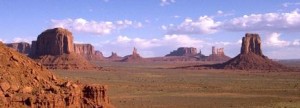Glen Canyon Dam
Located near the city of Page, Glen Canyon Dam is the impressive site of a plant that generates more than 1.3 million kilowatts of electricity with each of the 40-ton steel shafts turning at 150 rpm, generating nearly 200,000 horsepower. Since 1956 when the first blast was set off to begin building the impressive 3,700-foot dam, with all eight generators operating at full output, more than 15 million gallons of water will pass through the power plant’s penstocks each minute. The electricity is upgraded on a transformer deck from 13,800 volts to 230,000 and 345,000 volts for transmission to distant markets.
Visitors may tour the historic project free of charge beginning at the Carl B. Hayden Visitor Center perched above the lake and power plant. Kids will enjoy the guided tour featuring video, photography and Native American artifacts. This is an excellent family activity and one that should not be missed where you can plan to spend anywhere from 1 to 2 hours taking in the views, and exploring the history.
The tour begins at the Carl Hayden Visitor Center where an elevator will take you 528 feet deep into the interior of the dam. One stop along the tour is the gallery where a digital counter registers the money collected from the sale of power.
While visiting the dam, you may also be interested in the recreational facilities in the surrounding area:

